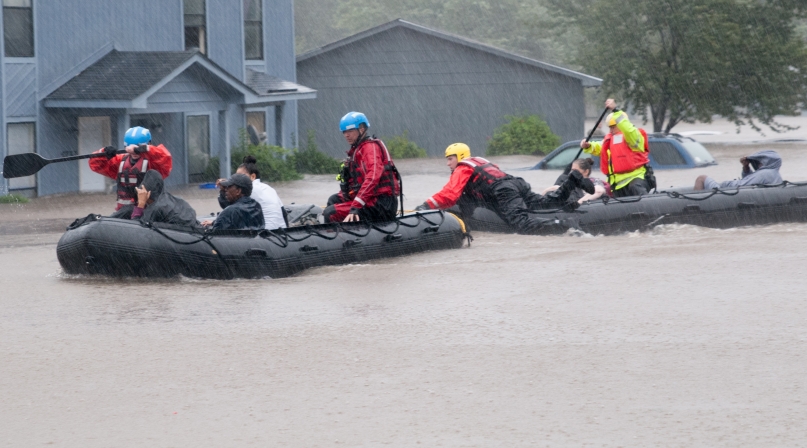Lowland N.C. counties surprised by Matthew’s northward turn

Delayed Hurricane Matthew flooding complicates responses in lowland N.C. counties
Hurricane Matthew’s northward turn relieved Florida but surprised North Carolina, where thousands have been displaced by flooding and almost two dozen have died. The flooding has prompted President Obama to declare a state of emergency in 31 counties.
The lowlands of the eastern part of the state had been hit the hardest. Robeson County, on the South Carolina border, is one of the largest in the state and has seen thousands of residents displaced and untold damage done as the Lumber River floods.
“We’re going to have a lot of work ahead of us,” said County Commission Chairman Jerry Stephens. “It’s going to be a long time until we figure out how much water damage we have.”
Stephens’ district includes the county seat of Lumberton, where 1,500 people were evacuated at the beginning of the week.
“People thought it was going to rain and they’d wake up in the morning and their backyard would be flooded,” he said. “Instead, it was the water that woke them up in the middle of the night. They never thought they’d be evacuating, and when you have to leave in the middle of the night it’s that much worse.”
Local roads, and I-95, have been flooded, bisecting the county and adding detour traffic to the mayhem.
Stephens has been hauling potable water across town in his pickup truck, and as of Oct. 12 wasn’t seeing water receding the way he had hoped.
“I’m still seeing a lot of boats,” he said. “We thought the water was going to be going down, but Monday it kept rising.”
The county has seven shelters operating, and Stephens has instructed the county’s mental health director to send service providers in.
“It’s going to be like people coming back from the military,” he said. “They’re okay, and people aren’t as grouchy as they normally would be to be put out like this, but that might change when they realize their houses and belongings could be gone.”
Rain or no rain, the general election is coming up on Nov. 8. Stephens was thankful that the state Supreme Court struck down the recently passed voter ID law.
“Could you imagine having to show ID to vote when your house was flooded and you haven’t been allowed to go back in yet,” he said. “If you’re leaving your house in the middle of the night because it’s flooded, taking your ID so you can vote in a month isn’t something you’re going to be worried about.”
Stephanie Chavis leads a five-person emergency services department, and as of Oct. 12, she had spent six straight days in the emergency operations center, sleeping and showering in built-in quarters.
“All I’ve seen is what’s outside of my window,” she said. “Things look nice from here, but I know it’s not like that all over the county.”
She said they had no reasonable estimate of how much rain they should expect, but the extent of the flooding was apparent Oct. 8.
The state and federal assistance for her small staff has been crucial, she said, given the size of her county — 951 square miles, the sixth largest in the state and within reach of fourth place.
Moore County, to the northwest of Robeson County, braced for a the failure of the Woodlake Dam before it was stabilized Oct. 13, but residents are still discouraged from returning.
Closer to the coast, in Pitt County, the water at 25 feet, up with the normal 13 feet, and Commissioner Glen Webb said National Oceanic and Atmospheric Administration estimates pegged a 30-foot crest in the coming days as the Tar River flowed and the Neuse River starts to back up from Lenoir County.
“It’s been gradual and that’s the tough part for us,” he said. “We’ve had three beautiful days in a row, and it’s hard to convince people to evacuate when the wind isn’t blowing 70 miles per hour and rain isn’t falling.”
In addition to roads washing out, Webb expects several bridges to be destroyed.
For residents who lived through Hurricane Floyd in 1999, warnings have been enough.
“If they remember Floyd, they know how bad it can get,” he said. “Generally, people are listening. The big thing is telling them if there’s water over the roads, there’s water under it, and you don’t want to be the one to break through because the sand has washed out.”
To the northwest of Pitt County, in Edgecombe County, Commission Chairman Leonard Wiggins said that beyond flooding in Princeville and Tarboro, which were evacuated, things have generally been better than during Floyd.
He’s flown over the county a few times to inspect the extent of the flooding.
“There’s a lot of water,” he said. “A lot of roads are impassible, and we don’t know what we’re going to see once the water is gone.
“We’re not expecting much more water, but we’re not sure how fast it will go down.”
In Florida, coastal Flagler County has totaled its individual damage estimate at $72 million, which did not include public infrastructure.
County boards of elections were closed for two days, but a federal judge extended the voter registration deadline by a week until Oct. 18. The Broward County Board of Elections is extending working hours to make up for the lost two days, in the face of increase voter registrations.
Attachments
Related News

White House launches federal flood standard support website and tool
On April 11, the White House launched a new website and mapping tool to help users with the ongoing implementation of the Federal Flood Risk Management Standard (FFRMS).

Counties offer a second chance after incarceration
From job fairs and housing programs to educational opportunities, counties offer a second chance after incarceration.

